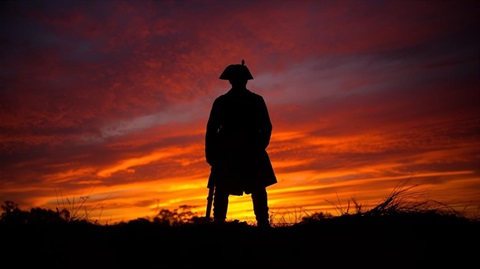Revolutionary War Soldiers at Rest in Brentwood

On July 4, 2026, the United States of America will celebrate its 250th Anniversary, and leading up to that event, the Brentwood Historic Commission will commemorate the Revolutionary War veterans who are buried within the city limits.
The late Brentwood Historian Vance T. Little wrote, “Middle Tennessee did not see action during the Revolutionary War, but many Veterans of that conflict came to Tennessee to take up North Carolina Revolutionary War grants or to get a new start in life. Some settled in what is now Brentwood, and nine are buried here."
Revolutionary War Soldiers at Rest in Brentwood:
(The information below is a compilation of works by Little, Louise Lynch, Kathie Greaves and Charles Cox)
ANDREW CROCKETT was one of three Crockett brothers who owned several hundred acres in Brentwood. Between the three Crocketts, they owned almost 2,000 acres. They came from Wythe County, Virginia. Andrew was the only one who moved his permanent residence here. He owned 640 acres that included what is now Crockett Park, Forge Seat and most of Brenthaven subdivision. He served as a lieutenant in the Virginia State Militia. In spring 1779, settlers established a permanent settlement on the Cumberland at Fort Nashborough (now Nashville) and created the "Articles of Agreement or Compact of Government," which Crockett signed on May 1, 1780.
GREEN HILL came to Williamson County in 1799 from Louisburg, North Carolina. Before coming to Tennessee, he held many influential political positions in North Carolina. He represented North Carolina in four Continental Congresses. He was elected Treasurer of the Halifax District of North Carolina during the Revolutionary War. He is credited with saving the treasury and records of the district before the advance of Cornwallis’s army. He was commissioned as a major in the North Carolina Militia. He was instrumental in the spread of Methodism on the Tennessee frontier. He founded the historic Liberty United Methodist Church in Brentwood.
BENJAMIN HUMPHREY was born in Virginia in 1758. He lived in Surry County, North Carolina and Virginia during the Revolutionary War. He served in the 4th, 8th and 12th Virginia regiments of the Continental Lines. He was later promoted to lieutenant in the North Carolina Militia from Surry County. He married Jane Lawrence in NC. He came to Williamson County in 1805 and bought 153 acres of land on Mill Creek. He lived at what is now the intersection of Concord Road and Waller Road in Brentwood.
DAVID JOHNSTON served in the Revolutionary War as a private in the Mecklenburg North Carolina militia. He lost his left arm in the battle of Tiger River, South Carolina, in 1780. Because of his disability, he was given a pension in 1789 while a resident of Ashe County, North Carolina. His grandson, James Johnston, built the historic Isola Bella mansion on the corner of Concord and Franklin Road.
JOHN JOHNSTON was born in Tyrone County, Ireland and lived in Bucks County, Pennsylvania before moving to Tennessee. He served as a major in the Revolutionary War. His son, Matthew Johnston, founded the Johnson Chapel, United Methodist Church.
MOSES LINDSEY was born in 1762 in Quaker Colony in Frederick County, Virginia. He followed the Quaker migration to Newberry County, South Carolina, and settled on the Bush River. While living there, he enlisted in Captain Garrett’s South Carolina company in the Revolutionary War. He fought in the battles of Musgrove’s Mill, Fish Dam Ford, Blackstocks, and Cowpens. He was in the Siege of Ninety-Six and the Siege of Augusta. While there, he fought in the battles of Fort Grierson and Eutaw Springs. He lived in Newberry County until he moved to Williamson County in 1810.
JAMES MOORE was born in 1764 in Mecklenburg, North Carolina and married Eleanor Irwin, the daughter of General Robert Irwin. Eleanor Irwin Moore was born in 1771. James and Eleanor emigrated to Williamson County, Tennessee, quite early, and Eleanor died of typhoid fever in 1809, leaving a family of small children. James Moore married Sarah Alfred in 1810. According to his obituary, James Moore was “a short time in the Revolutionary War, though but a boy” posted in The Western Weekly Review, Franklin, Tennessee, 27 JUL 1838. In spring 1779, settlers established a permanent settlement on the Cumberland at Fort Nashborough (now Nashville) and created the "Articles of Agreement or Compact of Government," which Moore signed on May 1, 1780.
THOMAS BRADLEY fought at the Battle of Guilford Courthouse at the age of 15. He is listed on a North Carolina payroll and later as a Tennessee pensioner. He married Margaret Norton in 1791, and moved to Tennessee in the 1790s, having six children. In 1802, he acquired 640 acres on the Little Harpeth River, expanding to 1120 acres by 1821 where Brentwood Library now stands. He served in many County Commissions and as captain in the TN Militia. Thomas and Margaret were buried near their home, but markers disappeared by the 1990s, and the cemetery is now a natural area behind the Brentwood Library.
THOMAS COX was born on June 7, 1761, in Baltimore County, Maryland, to John Cox and Elizabeth Sympson. Around 1774, he moved with his family to what is now Sullivan County, Tennessee. In spring 1779, settlers established a permanent settlement on the Cumberland at Fort Nashborough (now Nashville) and created the "Articles of Agreement or Compact of Government," which Thomas Cox signed on May 1, 1780. He received two land grants for his service as a guard for land commissioners and later settled near Otter Creek in Davidson County.